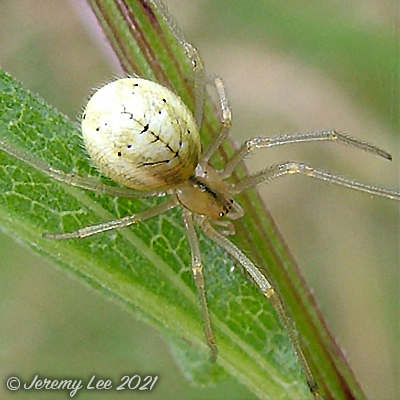
 |
|
Scientific Classifications explained » Amphibians » Ants » Aphids » Bees » Beetles » Birds » Bugs » Butterflies » Caterpillars » Damselflies » Dragonflies » Earwigs » Flies » Frog/Leafhoppers » Fungi » Galls » Grasshoppers » Harvestmen » Hoverflies » Lacewings » Ladybirds » Leaf Mines » Lichens » Mammals » Millipedes » Mosses » Moths » Sawflies » Slugs » Snails » Spiders » Trees & Shrubs » Wasps » Wild Flowers » Woodlice » Postboxes |
UK Nature > Spiders > Enoplognatha ovata

Scientific Name: Enoplognatha ovata Common Name: Comb-footed Spider Enoplognatha ovata is a species of spider belonging to the family Theridiidae and is widespread throughout the UK. It can reach a length of 6 mm (excluding legs), has translucent legs and the globular abdomen is extremely variable in colour and pattern: the background colour is white, cream or green and can be marked with a row of dark spots, a broad red stripe or with two red stripes in a v-shape. Despite its small size, this is a formidable predator which can prey on insects many times its size. It is a species typical of open habitats containing low broad-leaved vegetation, e.g. road verges, domestic gardens and woodland glades. After mating, males die and females establish themselves in rolled leaves to produce and guard their (usually) single bluish egg-sac. Once the young emerge from the rolled leaf in September, the female wanders off to die, and the young descend to grass-roots level to over-winter. |
|

https://www.uknature.co.uk is a website dedicated to showing the immense diversity of UK nature and wildlife. Our vast range of habitats, from lowland arable to snow covered mountains, from storm-ravaged coastlines to peaceful inland freshwater lakes and rivers, from dry, sandy heaths to deciduous and coniferous forests, all these habitats contribute to the abundance of UK nature. We have wild birds in huge numbers either residing or visiting our shores (597 recorded species as at July 2013) and we must also not forget the humble back garden with its grass lawns, flower beds filled with nectar rich flowers, shrubs and trees, all designed to attract huge numbers of insects such as bees, moths, butterflies and hoverflies; and finally the small ponds which provide safe havens for frogs, toads, newts and even slow worms and grass snakes. www.uknature.co.uk is the showcase for my personal passion, photographing uknature in all its glory. I sincerely hope you all enjoy the fruits of my labours. This site and all images contained therein is © Jeremy Lee 2004 - 2025. All Rights Reserved. Site design by Jeremy Lee. Site development & IT Support by Stuart Lee. |